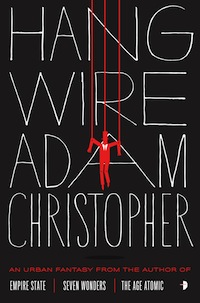Early in Hang Wire, Adam Christopher’s new urban supernatural thriller, a San Francisco blogger named Ted is sitting in a Chinese restaurant with some of his friends and colleagues, enjoying a meal. They have gathered to celebrate Ted’s birthday and exchange pleasantries and bask in one another’s company. The friends go around the table and open their fortune cookies, one after another, and read them aloud, performing the dinner ritual. Finally they get to the birthday boy, Ted, and he picks up his fortune cookie and opens it and it literally explodes in his hands, like a crunchy hand grenade with enough force to knock Ted to the floor and overturn the dinner table.
Ted, eerily unharmed, finds himself flat on his back, not entirely sure what just happened to him. He is not especially disturbed by the event nor, importantly, does he seem to have enjoyed his cookie much. This is a fair approximation of the impact of Hang Wire itself.
After the explosion Ted experiences odd episodes of somnambulism. He begins to wonder what he’s doing with his lost time, as the city of San Francisco is being prowled by the Hang Wire Killer, a serial murderer whose modus operandi is to gruesomely string up his victims with improbably large gauge steel wire, positioning them like ghastly marionettes. Even though the worst thing most sleepwalkers are liable to get up is maybe peeing in the bathroom clothes hamper, Ted seems to pretty quickly consider himself a viable suspect in the murders.
At the same time, the circus has come to town, the Olde Worlde Funfair, with an ominously relevant high wire act in the big top, and a strange troupe of Celtic dancers on the midway, jiggling in pagan fire worship, all overseen by a creepy old circus manager with a mysterious past. It’s possible that this circus has some connection to an ancient and eternal evil, although surely that’s the first thought one inevitably has on encountering any circus, whether in prose or in real life.
It is this creepy circus manager, Joel, who is the most well wrought and resonant character. We see him in a number of episodes, the course of which spans epochs, starting back in the Civil War and moving up through the present day. A few of these are legitimately horrifying, and tread on the borderlands of Stephen King territory, with the creepy old man walking the ages, grinning terribly, and fondling a weird old coin that seems to travel with him everywhere and everywhen.
The other main character, Bob, seems the most likeable and believably Californian of the bunch (though, of course, he’s not from around here). Bob is an aging, faded, movie-star-handsome beach bum, who teaches dowager tourists ballroom dancing on the sand between the Maritime Museum and San Francisco Bay. He seems to belong to a book more about LA than SF but hey, close enough.
This does draw attention to one of the book’s flaws, however, in that it’s a San Francisco novel that doesn’t really feel very San Franciscan. The landmarks are there, the neighborhoods, the historical touchstones (the apocalyptic 1906 earthquake features prominently in one early scene), but the genius of the place is absent. The forty-niner spirit of the goldrush, the city’s Latino heritage, the bohemian individualism, the history as gay mecca of the 20th century, and ground zero of the 21st century tech gentrification bomb, all these are missing at Hang Wire’s core. It’s like when you watch a Jackie Chan movie that purports to be set in the Bronx, but you can tell it’s not. Even if you’ve never been to the Bronx, you can tell. (Hint: it’s actually Vancouver.)
The book’s strength is rooted in a game willingness to throw a bunch of really random things in a blender and press “chop.” Creepy carnivals, ancient evils, serial killers, supers, Celtic pagans, Hawaiian gods, Korean gods, ancient evil gods, all kinds of gods. Ballroom dancing. There’s nothing here that would feel particularly out of place if recast as an episode of Supernatural, or one of the later seasons of Angel, or, to put it back on literary ground, some of the tamer works in the canon of China Miéville. It’s a lot of fun, and gives the story a real forward motion as you wonder what weird thing Christopher is going to take out of his hat next.
This is also a pretty serious weakness of the novel however, as the elements that make up the bits of this narrative Ben & Jerry’s here (call it “Ye Olde Worlde Chunkfair”) also feel indiscriminate. There is a basic world cohesion that the book lacks. None of these disparate elements really feels essential to the novel, or seems to have an irreplaceable part to play in the story. They seem to be on the page because they seemed cool at the time. Which, to be fair, is not a terrible reason to put something in your book, but at the same time, a lot of Hang Wire feels like the soup you make when you have to use up all the food in the refrigerator before it goes bad.
Still, for a light urban paranormal mystery, you could do a lot worse. Hang Wire has some fun situations and creations (seriously, Bob is great), and can be read agreeably fast. It’s the equivalent of a mid tier summer movie you didn’t want to see in the first place, but once you do, it’s hard to say exactly how you feel about it but you realize you maybe kinda enjoyed yourself and don’t at all begrudge the time you spent in the theater.
Sometimes what you’re in the mood for is a fortune cookie blowing up in your face.
Hang Wire is available now from Angry Robot Books.
David Moran lives in San Francisco, and has for kind of a while now. He even works for a startup and everything. You can read his Twitter.










